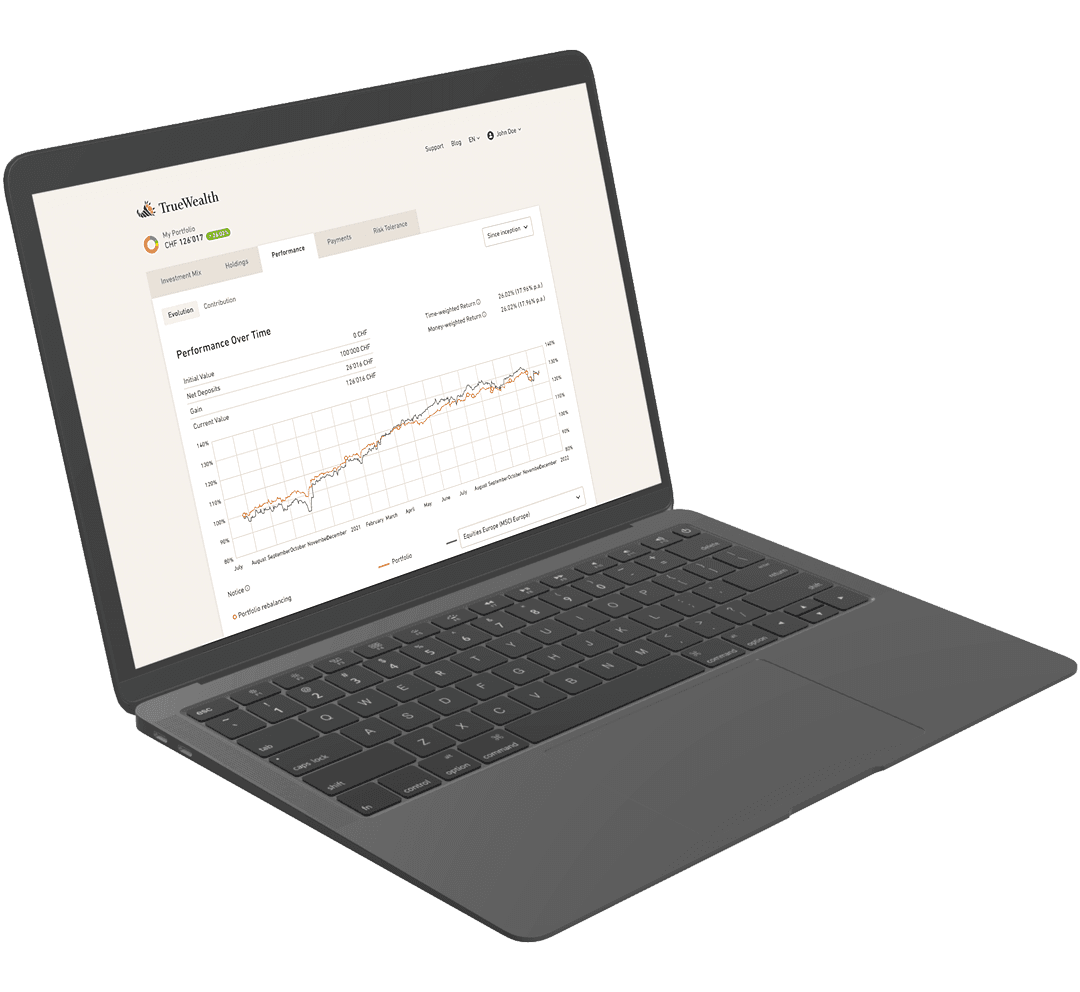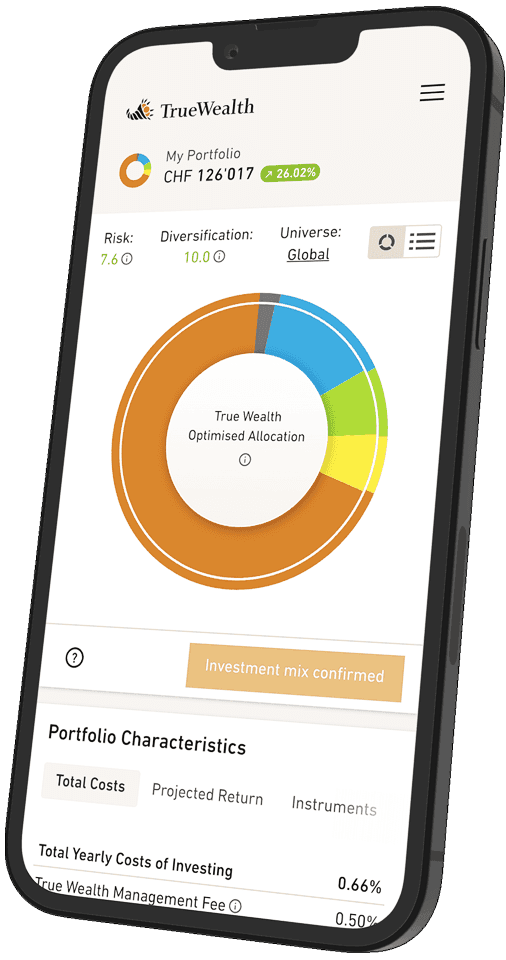
How Do You Exchange 50 Million in an ETF?
We choose exclusively liquid ETFs with low bid-ask spreads. But how do we proceed if we need to trade a large amount on the stock market at once?
At True Wealth, we make every effort to use the best investment instrument for each individual asset class. Whether it's Swiss blue-chip stocks, inflation-linked bonds, American small caps, precious metals, corporate bonds, real estate stocks, high yield bonds, or equity participation in emerging markets, we always strive to use the best and most efficient ETF.
But what to do if the situation changes and a new ETF turns out to be a notch better?
What Is the Cost of a Swap?
Exchanging an ETF usually means selling the existing ETF and using the proceeds to buy a new one. But there are three types of transaction costs involved: Firstly, brokerage fees to the security brokers. These are included at True Wealth, we take care of them for you (for more information see our fees). Secondly, in addition to the investment banks, the Swiss tax authorities also take their toll and charge a percentage of the traded volume (0.075% for Swiss ETFs and 0.15% for foreign ETFs) on every purchase or sale of securities such as ETFs. Thirdly, somewhat hidden but often the biggest cost factor is this: Equities and ETFs have a bid-ask spread that often exceeds the brokerage fees many times over.
When changing investment instruments, the benefits must outweigh the costs. That is why we don't switch ETFs every month – often two or three ETF providers will go head-to-head over a longer period of time to offer the best conditions for an asset class.
US Equities: Head-to-Head Race
However, for US equities, one of the most important asset classes of all, we have come to the conclusion that a change of investment instrument is worthwhile for our clients, especially if it is possible to keep the bid-ask spread small when exchanging.
What you need to know about US equities: ETFs domiciled in Europe lose a portion of the dividends paid out by the stocks held in the fund. Similar to the Swiss withholding tax, the American treasury also applies a withholding tax of up to 30% on the stock dividends. Depending on the double taxation agreement (DTA) with the USA, the ETF thus misses out on part of the dividend yield. One of the most advantageous DTAs for ETFs with the USA is currently in Ireland, because a reduced withholding tax rate of 15% instead of 30% applies to ETFs domiciled there. To illustrate: With a dividend yield of typically 2%, this tax advantage provides those ETFs domiciled in Ireland with an annual return advantage of 0.30% (2% x 15%).
In addition to this tax effect, other factors are also decisive, in particular low management costs, i.e. TER (Total Expense Ratio), good liquidity of the ETF, as well as the way in which the ETF tracks the index. One indicator for the future liquidity of an ETF is its total volume: The more the better.
The ETF of Xtrackers that we chose performs better on all of these points, as demonstrated in the table below:
The new ETF also performs slightly better in a historical comparison:
Professional NAV Switch Trade
For this reason, we came to the conclusion to switch the existing ETF. But how? In the totality of our client portfolios, we had around 50 million US dollars invested in this instrument – simply selling the ETF on the exchange and buying the new one would have widened the bid-ask spread to the detriment of our clients, and was therefore out of the question for us.
So instead, we took a different approach here and approached the so-called Authorised Participants (AP). APs are special market makers who, on the one hand, guarantee a minimum level of liquidity for the ETFs they manage on the exchange and, on the other hand, ensure that the price of the ETFs never deviates too far from its intrinsic value. The intrinsic value is derived from the securities effectively held by the ETF, which is also called the NAV (net asset value).
For this purpose, APs can have new shares created or redeem shares with the ETF producer, hence the name Authorised Participant. For example, if the traded price of an ETF exceeds the intrinsic value, the AP orders new shares from the ETF producer and sells them on the market. Conversely, if the market price of the ETF is at a discount to the intrinsic value, the AP buys shares of the ETF in the market and returns them to the ETF producer. In both cases, the AP makes a small profit, which compensates for the risk that the market may move against them in the short term.
In this daily business for APs, they can subscribe to ETF shares from ETF producers in exchange for money, or return ETF shares in exchange for a corresponding cash payment, similar to a subscription or redemption in the case of an investment fund.
Instead of paying money for ETF shares, APs can also pay the ETF producer with a suitable basket of securities or be compensated for the return of the ETF shares with such a basket.
It is precisely this ability that allows the AP to unpack the American shares in our old ETF, and to return them to us repackaged in the form of the more efficient ETF.
This ETF-for-ETF transaction is called a NAV switch trade because the exchange ratio is not determined by the prices of the ETFs but instead by the ratio of their intrinsic values (NAV). This type of transaction is possible from a volume in the double-digit million range.
Advantages for Our Clients
This NAV switch trade procedure has tangible advantages for you as a client: It allowed us to avoid widening the bid-ask spreads due to the size of the transaction (about USD 50 million) and thus generating painful transaction losses. This transaction also never created a market risk for the AP, which is why we were even able to implement the ETF switch completely free of a bid-ask spread for our clients. Another advantage was that the exchange was also free of market risk for you as an investor: There was never a second where the old ETF would have been sold before the new one was bought, or vice versa.
Conclusion: As asset managers, we have means at our disposal that are usually not open to private investors. This means that we can also exchange securities in an efficient manner, sometimes even without any spread costs, i.e. bid-ask spreads. It is important to us to get the maximum out of this for our clients.
We would love to do more for you soon!
Notes
- Regarding ETF selection: We prefer physical replication with real securities to synthetic replication via a derivative contract, which is why we did not use ETFs with the Xtracker label in the past, but this has now changed as the Xtracker ETFs are increasingly also offered with physical replication.
- We made the exchange of an ETF described above in the corresponding customer portfolios with our global investment universe at the end of November 2021. We subsequently carried out a similar exchange in our sustainable investment universe, although the volume here was somewhat smaller; in this case, too, the bid-ask spread of the NAV switch trade was very low at 0.02%.
- True Wealth does not offer tax advice.
About the author

Founder and CEO of True Wealth. After graduating from the Swiss Federal Institute of Technology (ETH) as a physicist, Felix first spent several years in Swiss industry and then four years with a major reinsurance company in portfolio management and risk modeling.

Ready to invest?
Open accountNot sure how to start? Open a test account and upgrade to a full account later.
Open test account